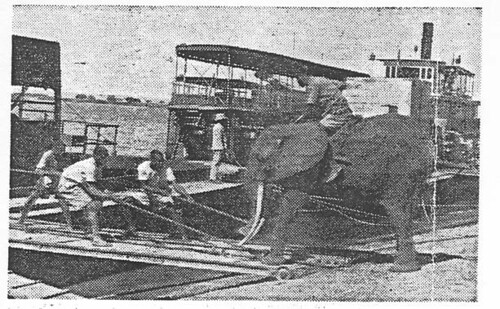| The photo here shows one of Bary's five 1936 ex-Gangala elephants boarding the Nile ferry at Juba, Sudan. This one looks different to me than any of those which reached America so I figure it was one of the two that died en-route. Bary brought with him six cornacks from Gangagla. Their names were Gumete, Kisango, Wayapi, Gumboio, Beulema, and Mobesi, the last named being the sergeant in charge. They appeared with their elephants for a few days during the opener in the Garden in 1936. However, immigration/entry problems were raised, and they were soon on their way back to Gangala. |
Wednesday, June 18, 2008
African Elephant Domestication #2
Posted by
Buckles
at
6/18/2008 06:17:00 AM
![]()
Subscribe to:
Post Comments (Atom)






3 comments:
This is excerpted from a website: "Mark Twain called Leopold the slayer of 15 million Congolese and a "greedy, grasping, avaracious, cynical, bloodthirsty old goat." His dark and graphic satire, 'King Leopold's Soliloquy: A Defense of His Congo Rule' is published in pamphlet form by the American Congo Reform Association in September 1905." http://www.moreorless.au.com/killers/leopold.html Another website said that Leopold II reduced the population of the Congo from 20 million to 10 million in 40 years.
I think that Bernard Heuvelmans, the father of cryptozoology and author of "On THe Track Of Unknown Animals" (1958) wrote about the supposed pygmy elephants in the Bronx Zoo. Forest elephants grow tusks when they are quite young and so they have been confused with pygmy adults. Bronx Zoo's pygmy elephants grew up. Also the Natives say there is a third variety of elephant in the forest and this contributed to the idea that a pygmy elephant existed, but the third type is the hybrid.
This is from the same website: In 1909 Arthur Conan Doyle published The Crimes of the Congo, his account of how under Leopold II's rule, the Congolese "have been robbed of all they possessed, debauched, degraded, mutilated, tortured, murdered, all on such a scale as has never, to my knowledge, occurred before in the whole course of history." http:/www.moreorless.au.com/killers/leopold.html
Post a Comment